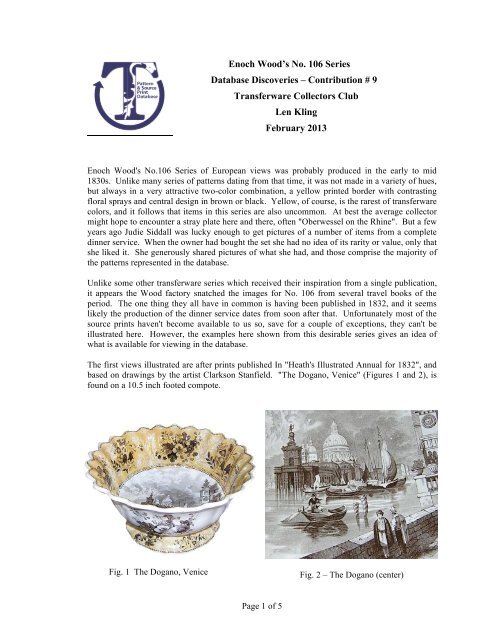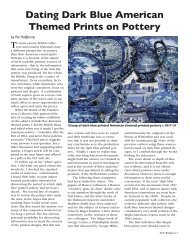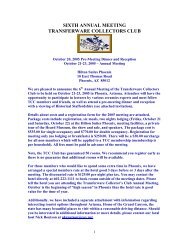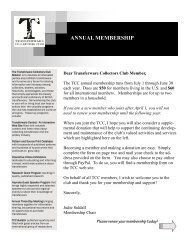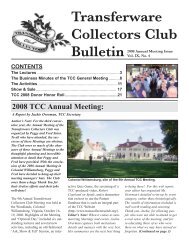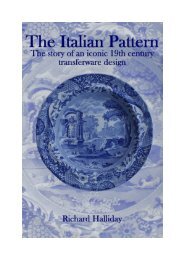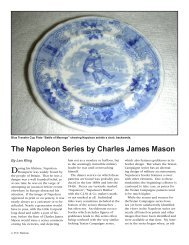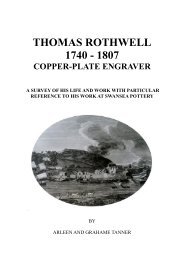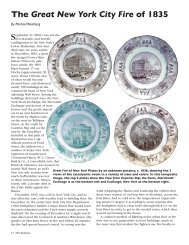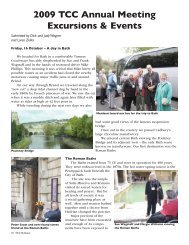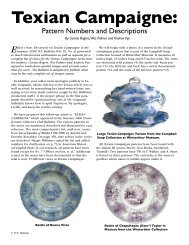Enoch Wood's Series No. 106 - Transferware Collectors Club
Enoch Wood's Series No. 106 - Transferware Collectors Club
Enoch Wood's Series No. 106 - Transferware Collectors Club
You also want an ePaper? Increase the reach of your titles
YUMPU automatically turns print PDFs into web optimized ePapers that Google loves.
<strong>Enoch</strong> Wood’s <strong>No</strong>. <strong>106</strong> <strong>Series</strong><br />
Database Discoveries – Contribution # 9<br />
<strong>Transferware</strong> <strong>Collectors</strong> <strong>Club</strong><br />
Len Kling<br />
February 2013<br />
<strong>Enoch</strong> <strong>Wood's</strong> <strong>No</strong>.<strong>106</strong> <strong>Series</strong> of European views was probably produced in the early to mid<br />
1830s. Unlike many series of patterns dating from that time, it was not made in a variety of hues,<br />
but always in a very attractive two-color combination, a yellow printed border with contrasting<br />
floral sprays and central design in brown or black. Yellow, of course, is the rarest of transferware<br />
colors, and it follows that items in this series are also uncommon. At best the average collector<br />
might hope to encounter a stray plate here and there, often "Oberwessel on the Rhine". But a few<br />
years ago Judie Siddall was lucky enough to get pictures of a number of items from a complete<br />
dinner service. When the owner had bought the set she had no idea of its rarity or value, only that<br />
she liked it. She generously shared pictures of what she had, and those comprise the majority of<br />
the patterns represented in the database.<br />
Unlike some other transferware series which received their inspiration from a single publication,<br />
it appears the Wood factory snatched the images for <strong>No</strong>. <strong>106</strong> from several travel books of the<br />
period. The one thing they all have in common is having been published in 1832, and it seems<br />
likely the production of the dinner service dates from soon after that. Unfortunately most of the<br />
source prints haven't become available to us so, save for a couple of exceptions, they can't be<br />
illustrated here. However, the examples here shown from this desirable series gives an idea of<br />
what is available for viewing in the database.<br />
The first views illustrated are after prints published In "Heath's Illustrated Annual for 1832", and<br />
based on drawings by the artist Clarkson Stanfield. "The Dogano, Venice" (Figures 1 and 2), is<br />
found on a 10.5 inch footed compote.<br />
Fig. 1 The Dogano, Venice<br />
Fig. 2 – The Dogano (center)<br />
Page 1 of 5
"Strasburg" (Figure 3) is on a 15 inch platter. "Trent" (Figure 4) appears on a 13 inch platter, and<br />
"Venice" (Figure 5) - actually a view of the Church St. Pietro di Castello in that city - is printed<br />
on a 7 inch plate.<br />
Fig. 3 - Strasburg<br />
Fig. 4 - Trent<br />
Fig. 5 - Venice<br />
At least two views were taken from "The Tourist in Italy", published in 1832, and were after<br />
drawings by John Duffield Harding. "Cetara, Bay of Salerno" (Figure 6) is on an 8 inch tray for a<br />
sauce tureen. The example in the database is mismarked "Corfu", however the source print<br />
(Figure 7) sets the record straight.<br />
Page 2 of 5
Fig. 6 – Cetara, Bay of Salerno<br />
Fig. 7 – Cetara, Bay of Salerno<br />
(source print)<br />
"Castle of Nepi" (Figure 8), is on a 9.25 inch plate.<br />
Fig. 8 – Castle of Nepi<br />
Page 3 of 5
"Bellagio, Lake of Como" (Figure 9), found on an 11 inch platter, was lifted from the pages of<br />
"Finden's Landscape and Portrait Illustrations to the Life & Works of Lord Byron". Henry<br />
Gastineau drew the original scene engraved for the book.<br />
Fig. 9 – Bellagio, Lake of Como<br />
Last of all is the view first mentioned above, "Oberwessel on the Rhine" (Figure 10), on a 10.25<br />
inch plate, along with its mark (Figure 11). Its source print, "Oberwesel (sic) on the Rhine" (Figure<br />
12) was from "The Literary Souvenir (for 1832)", published by Longman, Rees, Orme, Brown and Green,<br />
and was after a watercolor by the famous artist David Roberts, probably best known for his beautiful<br />
depictions of the Holy Land.<br />
Fig. 11 – Oberwessel on the Rhine<br />
(mark)<br />
Fig. 10 – Oberwessel on the Rhine<br />
Page 4 of 5
Figure 12 – Oberwesel (sic) on the Rhine (source print)<br />
Other views can be seen in the database, including the titled pieces "Dresden" and "Mainz", also a<br />
sauce tureen and a 17.5 inch platter which so far have not been identified. Sam Laidacker and<br />
other authorities state that the series was found on an extensive dinner service, which suggests<br />
that there may still be other pieces from the service out there. Has anybody seen them?<br />
www.transferwarecollectorsclub.org<br />
Page 5 of 5


